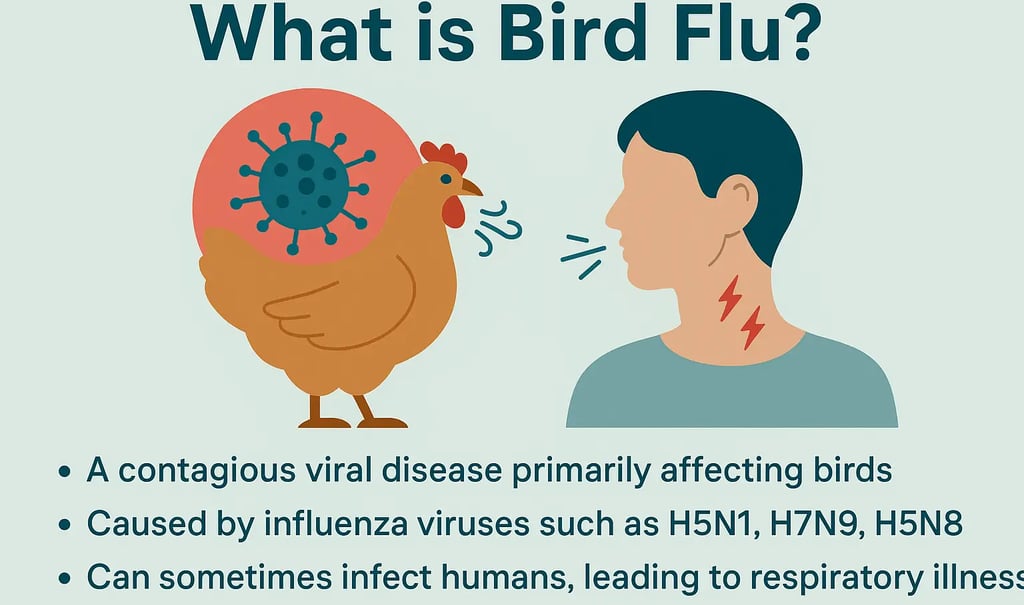What is Bird Flu (Avian Influenza)? Causes, Symptoms, and Treatment
Discover what bird flu is, including its causes, symptoms in birds and humans, and treatment options. Learn how avian influenza spreads and how to prevent outbreaks effectively.


What is Bird Flu?
Bird flu, also known as avian influenza, is a contagious viral disease that primarily affects birds, especially wild waterfowl and domestic poultry. Caused by influenza viruses from the Orthomyxoviridae family, bird flu can range in severity depending on the virus strain. The most well-known subtypes include H5N1, H7N9, and H5N8, categorized based on the surface proteins hemagglutinin (H) and neuraminidase (N).
While wild birds often carry these viruses without showing symptoms, domestic birds like chickens, ducks, and turkeys are highly vulnerable. In poultry, infections can lead to severe illness and large-scale mortality. The disease spreads rapidly through direct contact with infected birds, their secretions, contaminated surfaces, feed, or water.
Outbreaks of bird flu have been recorded globally, posing a threat not only to animal health but also to public health and the poultry industry. Although rare, some strains of avian influenza can infect humans, especially those in close contact with infected birds. Understanding how bird flu spreads and manifests is critical for effective prevention and control strategies in both animals and humans.
Causes of Bird Flu
Bird flu is caused by various strains of the avian influenza virus, which mainly infect birds. The viruses responsible for major outbreaks include H5N1, H7N9, and H5N8. These strains often circulate silently among wild migratory birds, making detection challenging since many carriers show no visible symptoms.
Transmission usually occurs through:
Direct contact with infected birds or their droppings
Contaminated environments, including cages, equipment, feed, and water
Airborne droplets in densely populated poultry farms
Migratory birds are a major concern as they can transport the virus over long distances and introduce it into new regions. The convergence of wild birds and domestic poultry—especially in backyard farms and open markets—creates ideal conditions for the virus to jump species.
Environmental factors like climate change, urbanization, and intensive poultry farming increase the likelihood of outbreaks. To prevent the spread, effective biosecurity practices such as controlling bird access, sanitizing equipment, and monitoring flock health are essential.
Symptoms of Bird Flu in Birds and Humans
In Birds:
Birds infected with avian influenza may show a range of symptoms, depending on the strain's severity:
Sudden and unexplained deaths
Difficulty breathing, coughing, sneezing
Swelling around the head, neck, or eyes
Lethargy and loss of appetite
Reduced egg production
Diarrhea
Neurological symptoms (tremors, unsteady movements, or paralysis)
Severe infections can cause rapid spread and high mortality in poultry farms, making early detection and response critical.
In Humans:
Though rare, bird flu can infect humans, particularly those who work closely with poultry or contaminated environments. Human symptoms often appear 2 to 8 days after exposure and include:
High fever
Cough and sore throat
Muscle aches and fatigue
Nausea, vomiting, or diarrhea (in some cases)
Respiratory difficulties, which may lead to pneumonia, respiratory failure, or even multi-organ failure
Prompt medical attention is vital, especially if symptoms are severe or involve underlying health conditions.
Treatment and Prevention of Bird Flu
In Birds:
Treatment options for birds are limited, but some antiviral medications like oseltamivir (Tamiflu) and zanamivir (Relenza) may help reduce disease severity if administered early. However, these are rarely used in poultry on a large scale due to cost and practicality.
Vaccination is a key preventive tool, especially in regions with repeated outbreaks. Vaccines can reduce viral shedding and transmission, helping protect flocks and prevent the virus from mutating or jumping to humans. Still, vaccination should always be part of a broader biosecurity strategy.
In Humans:
Human cases of bird flu are treated with antiviral drugs like oseltamivir, which work best when taken within 48 hours of symptom onset. Early diagnosis is crucial to reduce complications and prevent spread. In the event of an outbreak, health authorities may:
Isolate infected individuals
Trace and quarantine contacts
Cull infected bird populations to control transmission
Ongoing research is focused on developing better vaccines, improving diagnostic tools, and understanding virus mutations that may increase the risk of human transmission.
Key Takeaways
Bird flu is a viral infection primarily affecting birds but can occasionally infect humans.
Caused by strains like H5N1, H7N9, and H5N8, it spreads through direct contact or contaminated environments.
Wild birds act as carriers, while domestic poultry are more vulnerable to severe illness.
In humans, bird flu can cause flu-like symptoms and lead to serious complications if untreated.
Biosecurity, vaccination, and early medical intervention are essential in managing outbreaks and protecting public health.
